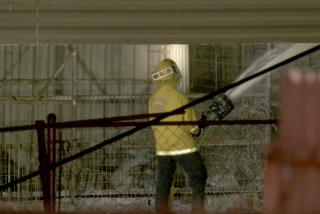A Sticky Business That Hums in No Time
- Share via
As a back-yard pursuit, beekeeping, like nuclear waste management, is not for everyone.
Imagine Mike Tyson with a poison javelin and the heart of a kamikaze warrior. These are bees. And when you become a beekeeper, they become your pets. They will teach you restraint.
They will also provide you with a fascinating example of communal urban living, they will help to coax your flowers and fruit trees into glorious bloom and they will crank out great gobs of honey that will make the store-bought stuff seem like Valvoline.
There is probably no starker example of the concept of getting what you pay for. Raw honey, straight from the hive, is one of the most sublime taste treats the earth can offer. Thousands of years before the invention of the fried pork rind, discriminating epicures were snacking on honey and sweetening other foods with it.
To get at it, however, they had to swipe it from creatures with a sense of territory that would make Marines defending a beachhead seem hospitable.
But, Morris Ostrofsky says, peaceful coexistence is possible, and the payoff is worth it. Ostrofsky, a biology teacher at Rancho Santiago College, has been keeping bees in his back yard for 15 years and sells beekeeping supplies out of his Tustin garage. The bees that live in his two back-yard hives, he says, produce about 300 pounds of honey each year and, for the most part, have been good neighbors. They also love his 15 fruit trees and have helped to keep them healthy, fragrant and productive.
Ostrofsky says he became fascinated as a youngster by a hive of bumblebees that had taken up residence at a friend’s house but later became further intrigued by honeybees because “these insects could make something that tasted so wonderfully good. It’s far superior to the honey you buy in the supermarket. It’s unheated, unfiltered, unpasteurized, un-everything.”
Store-bought honey, he says, is routinely heated, a process that clarifies the honey and makes it look appealing but upsets a delicate chemical balance and robs it of some of its flavor. Honey in its raw state often crystallizes and hardens and appears less pure, but one taste will tell you that looks aren’t everything.
If you really love the stuff and wouldn’t mind a limitless supply in your back yard, it’s pretty easy to get started, Ostrofsky says. You’ll need a hive, which looks like nothing more remarkable than a wooden box (beginners should start with a single box and gradually add boxes to the hive, he says). Inside the box are sections called frames, on which the bees will build honeycombs. They slide easily in and out of the box.
And you’ll need bees. You can buy them already in a hive, he says, or you can contact the U.S. Department of Agriculture. They will put your name on a list, and when a swarm is removed from a house you’ll be called to come and pick up the bees.
Or, he says, you can capture a swarm yourself. Often this involves nothing more than snipping off a tree branch that a swarm has landed on and carting the whole thing away.
And, yes, you’ll need protection: gloves, a protective jumpsuit and a netted helmet.
All this will cost you about $100, Ostrofsky says. But if you sell the honey your bees produce (Ostrofsky sells his honey for $1.50 a pound), the little workhorses will pay for your initial outlay in the first year.
Tending a hive can be learned from reading any of several books on the subject, says Ostrofsky, who occasionally teaches a class in beekeeping at Rancho Santiago College.
However, he says, you shouldn’t plunge in without checking the level of the neighbors’ enthusiasm. You’ll also want to check local beekeeping ordinances.
Generally, however, restrictive ordinances aren’t enforced unless a complaint is lodged, Ostrofsky, says, so butter up the neighbors.
Now, the part you’ve been waiting for: Expect to get stung. Even if you wear full protective gear, chances are that a bee or two will find a piece of exposed skin and decide to go out in a blaze of glory. You must therefore know whether you’re allergic to bee stings.
The only way to find out, he says, is to get stung. If the area around the sting swells up, that’s normal. If you have trouble breathing, you’re allergic and should give up beekeeping for something safer, like defusing unexploded bombs.
(You actually need to be stung twice to get a true determination, he says.)
If there’s no unusual reaction, though, and you decide to turn your back yard into Honey Central, you can probably look forward to becoming immune to the stings, like Ostrofsky. How many times does he get stung each year?
“It’s more realistic to ask how many times I get stung each day,” he says. “You generally stop reacting (to the stings) after a year. A lot of beekeepers get to the point where they stop wearing the protection.”
As does Ostrofsky. Once, while moving a hive, he tripped and the hive fell on top of him. He was stung, he says, 160 times “within a matter of minutes.”
Painful, he says, but no reaction.
What makes it all worth it, he says, is what he calls “the greatest pleasure for me in beekeeping:” the smell of ripening honey.
“It just perfumes the whole yard, and it’s just incredibly fresh and fragrant,” he says. “You just don’t get a smell like that in the city.”
There’s another advantage, one that even Ostrofsky--who acknowledges that some people are more afraid of bees than they are of the IRS--might not have thought of: home protection. The only problem with this is that bees are only aggressive when provoked, and at night they’re blind and almost immobile.
But how many burglars do you suppose know that?






